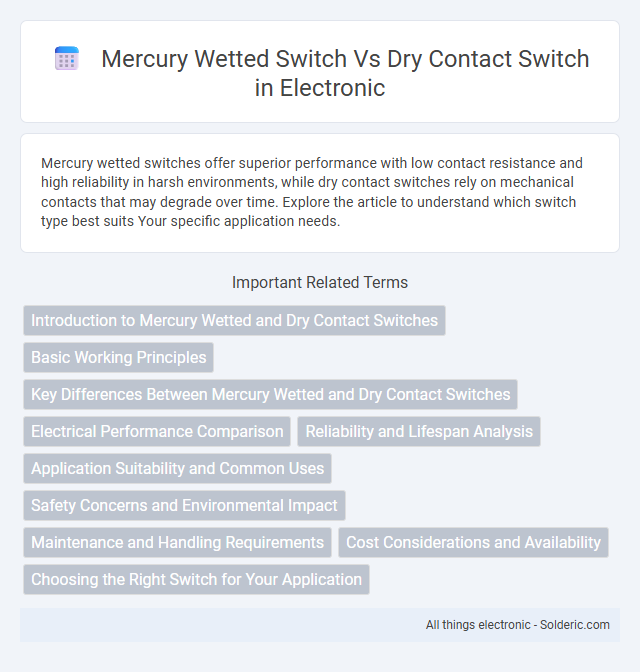Mercury wetted switches offer superior performance with low contact resistance and high reliability in harsh environments, while dry contact switches rely on mechanical contacts that may degrade over time. Explore the article to understand which switch type best suits Your specific application needs.
Comparison Table
| Feature | Mercury Wetted Switch | Dry Contact Switch |
|---|---|---|
| Contact Material | Mercury liquid metal | Metal contacts (silver, gold, etc.) |
| Contact Resistance | Very low (milliohms) | Higher, varies with wear and oxidation |
| Reliability | High, self-healing contacts | Moderate, contact wear and oxidation possible |
| Lifespan | Long, millions of cycles | Variable, shorter due to mechanical wear |
| Switching Speed | Fast response | Moderate speed |
| Contact Bounce | Minimal due to mercury | Noticeable bounce, may require debouncing |
| Environmental Sensitivity | Temperature-sensitive, mercury vapor risk | Less sensitive, safer environment |
| Application | Precision instrumentation, aerospace, industrial controls | General purpose, consumer electronics, automation |
| Safety | Toxic mercury hazard if broken | Safe, no toxic substances |
Introduction to Mercury Wetted and Dry Contact Switches
Mercury wetted switches use a small amount of mercury to create a low-resistance, reliable electrical contact, ensuring fast switching speeds and minimal contact bounce. Dry contact switches, in contrast, rely on physical metal-to-metal contact without any liquid conductor, often resulting in higher resistance and potential contact wear over time. Your choice depends on application requirements like response time, durability, and sensitivity to contact contamination.
Basic Working Principles
Mercury wetted switches operate by using a small amount of liquid mercury to establish a highly reliable and low-resistance electrical connection when actuated, ensuring minimal contact bounce and exceptional repeatability. Dry contact switches rely on mechanical contacts that physically touch to open or close a circuit, which can lead to higher contact resistance and potential wear over time. Understanding these fundamental differences helps you select the appropriate switch type based on precision and longevity requirements.
Key Differences Between Mercury Wetted and Dry Contact Switches
Mercury wetted switches utilize a layer of liquid mercury to ensure low contact resistance and reliable, bounce-free switching, making them ideal for precision and high-frequency applications. Dry contact switches rely on physical metal-to-metal contact without liquid, often resulting in higher contact resistance and potential contact bounce, which may affect sensitive signal integrity. Your choice depends on the need for durability, conductivity, and application environment, with mercury wetted switches offering superior performance in critical electronic circuits compared to conventional dry contact switches.
Electrical Performance Comparison
Mercury wetted switches exhibit lower contact resistance, typically in the range of 10 to 50 milliohms, resulting in superior electrical conductivity and minimal signal loss compared to dry contact switches, which often have higher and more variable resistance due to oxidation and contact wear. Mercury wetted switches maintain stable electrical performance over millions of cycles with negligible contact bounce, enhancing reliability in precision applications, whereas dry contact switches are more prone to contact degradation and increased electrical noise over time. The superior arc suppression characteristics of mercury wetted switches also contribute to longer life and improved switching performance under inductive loads.
Reliability and Lifespan Analysis
Mercury wetted switches exhibit superior reliability due to their low contact resistance and resistance to oxidation, resulting in consistent performance over millions of cycles. In contrast, dry contact switches often suffer from contact wear and contamination, leading to higher failure rates and shorter lifespans. The sealed environment of mercury wetted switches minimizes mechanical wear and environmental degradation, significantly extending operational longevity.
Application Suitability and Common Uses
Mercury wetted switches excel in applications requiring low contact resistance and reliable performance in harsh environments, such as aerospace, medical devices, and precision instrumentation. Dry contact switches are commonly used in general-purpose circuits, industrial machinery, and consumer electronics where cost-effectiveness and ease of integration are prioritized. Your choice depends on the need for durability and electrical stability versus versatility and affordability.
Safety Concerns and Environmental Impact
Mercury wetted switches pose significant safety risks due to the toxic nature of mercury, which can cause environmental contamination and health hazards if the switch breaks or leaks. Dry contact switches eliminate these risks by using inert materials, making them safer for both users and the environment. Your choice should emphasize minimizing exposure to hazardous substances while maintaining reliable switch performance.
Maintenance and Handling Requirements
Mercury wetted switches require minimal maintenance due to their sealed construction, which prevents contamination and contact oxidation, ensuring long-term reliability. Handling these switches demands caution to avoid breakage and mercury exposure, necessitating compliance with safety regulations and proper disposal methods. In contrast, dry contact switches often need regular cleaning and inspection to maintain contact integrity, with simpler handling but a higher risk of wear and environmental degradation.
Cost Considerations and Availability
Mercury wetted switches generally incur higher costs due to their specialized manufacturing process and the use of toxic mercury, which requires strict handling and disposal regulations. Dry contact switches are more widely available and cost-effective, benefiting from simpler construction and mass production, making them a popular choice in budget-sensitive applications. The availability of mercury wetted switches is limited owing to environmental restrictions and decreasing demand, whereas dry contact switches are readily accessible across various industries worldwide.
Choosing the Right Switch for Your Application
Mercury wetted switches offer low contact resistance, high reliability, and excellent resistance to contamination, making them ideal for precision applications requiring minimal signal loss and long-term stability. Dry contact switches provide versatility, lower cost, and are widely available in various configurations, suitable for general-purpose switching where contamination or oxidation is less critical. Choosing the right switch for your application depends on factors like contact resistance requirements, environmental conditions, expected lifespan, and sensitivity to oxidation or corrosion.
mercury wetted switch vs dry contact switch Infographic

 solderic.com
solderic.com